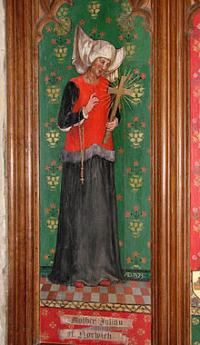
Julian of Norwich
Feast day: 13 May
Julian of Norwich is not a canonized saint, though there are many saints who are not canonized, and she does has a feastday in the Roman Catholic tradition. We know very little about her life. She does not even give us her name, but four wills refer to a recluse called Julian who lived at St Julian’s church, Norwich. Julian was an anchoress, a woman who lived in a cell beside a church and was usually walled in; the word anchorite or anchoress indicates withdrawal. The cell would often have three windows. One would have a view of the altar so that she could hear mass; there would be a window through which food would be passed and refuse removed; and through a third window people could consult with the holy woman. Margery Kemp, another visionary, records that in 1413 she visited Julian to explore her own visions with her. The anchoress was deemed to be dead to the world and the rite of enclosure was like a burial service. Often the woman would be buried in her cell.
We assume Julian to have been born in 1342, as she dates her revelations as 1373 when she informs us that she was thirty. She was therefore almost an exact contemporary of Geoffrey Chaucer. She was the earliest woman to be identified as writing in English. There are two texts that have come down to us, the short and the long. The short seems to have been written shortly after her revelations and to have been some kind of memorandum. The long version was produced after about twenty years of reflection on what she had experienced and the development of her thought and understanding over this period.
For a long time there was only one copy of the short text and only three more of the long. It seems that Julian’s work only began to have widespread popularity after the publication of Grace Warrack’s 1901 edition with modernised language. It then began to be widely translated.
Julian describes the prelude to fifteen revelations which took place on 8 May and one on the following night. She had previously prayed for three graces; the first was to relive the Passion of Our Lord, the second was bodily sickness and the third was to receive three wounds by the gift of God, which would be the wound of contrition, the wound of compassion and the wound of the purposeful longing for God. Julian tells us this desire came from the knowledge of the three wounds in the neck of the martyr St Cecilia. Julian did become ill and almost died. The priest who visited her held a crucifix up to her and as she became conscious of this cross she began to recover. Then she saw blood flowing from under the crown of thorns.
Julian’s visions are quite complex and would need a detailed exploration to do them justice. For those who want to read more, Julian of Norwich: Revelations of Divine Love, published by Oxford Classics and with an excellent introduction by Barry Windeatt, is recommended. Here are just a few of the themes of her revelations.
Julian’s request to relive the Passion seems to have been granted for she had a profound experience of Our Lord’s physical suffering, much of it visual. She lays great emphasis on the fact that Jesus suffered out of love and would have suffered more if he could. She describes him unusually as "mother". Jesus has given birth to us through his Passion and death, feeds us with the Eucharist and nurtures us tenderly. For a woman living a solitary life she seems to have a very positive idea of motherhood. Though she has a horror of sin which she feels is worse than hell, she emphasizes the love of the Trinity for humanity and uses a story or a parable of the servant to show that God does not allocate blame. Her picture of creation as a little nut is particular pleasing as it gives the image of God holding it gently in his hand. Her picture of Mary is poignant in its simplicity; she sees her as young girl when she conceived, at the foot of the cross and lastly in glory. Julian describes the soul divided into two parts; the upper part which can only desire God and the lower which is our animal nature. It is like a city where Jesus resides as king, a metaphor not unlike that which Teresa of Avila used in "Interior Castle." Her revelations gave her many insights into prayer which are very helpful. The core message appears to be that Jesus is at the centre of our prayer, so that what we ask for he has already initiated. She also encourages persistence in prayer even when it is arid.
Julian of Norwich was a medieval woman, with the concepts of hell and the devil of her day. Yet the revelations seem to take her far beyond this to contemplate a homely (her own word), courteous, merciful God, with the three persons clearly defined. Her phrase "motherhood of mercy" is very much in keeping with the image Pope Francis has asked us to reflect on in the Year of Mercy. For a woman who lived at the time of the Black Death, which wiped out at least third of Europe, her words "But all shall be well, and all manner of things shall be well" have an optimism which should hearten us all.
Julian of Norwich pray for us
The image above is of Julian of Norwich as depicted in the church of SS Andrew and Mary, Langham, Norfolk. The Church of St Julian in Norwich was almost destroyed by a bomb in 1942 but it was rebuilt in 1953.